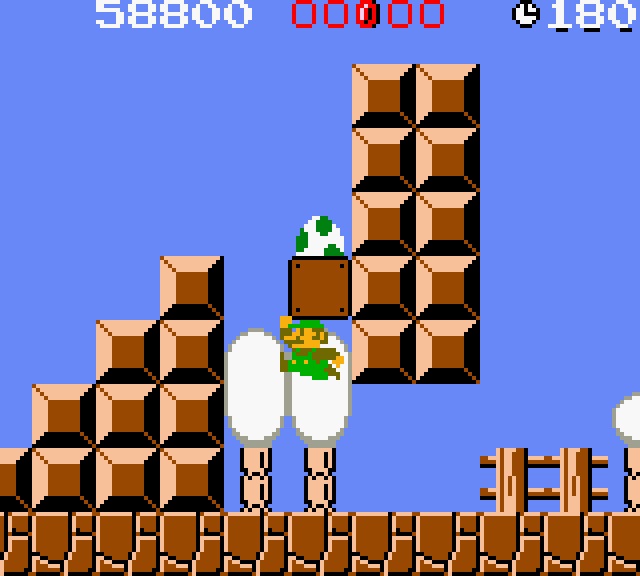16. World 8-3
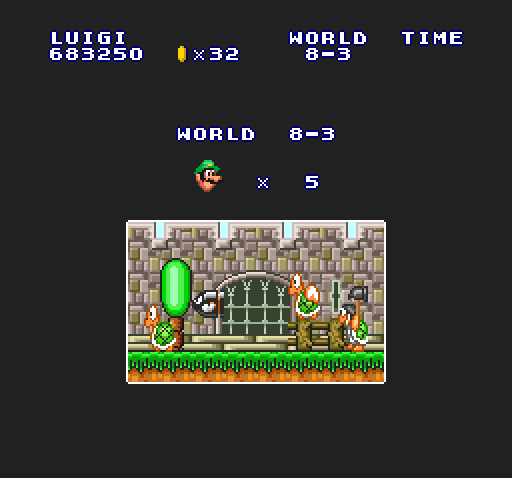
I’m torn on this level. It’s so memorable, specially the way it just unrelentingly sics Hammer Bro after Hammer Bro after you, the hardest enemy in the game. It’s fitting for the final non-castle level. The brick castle backgrounds, unique to this level, also makes this level stand out — specially in a final world that so far had shown the least aesthetic variety, with both 8-1 & 8-2 having the same graphic style as the 1st level — & drive home that this is the lead up to the final castle. 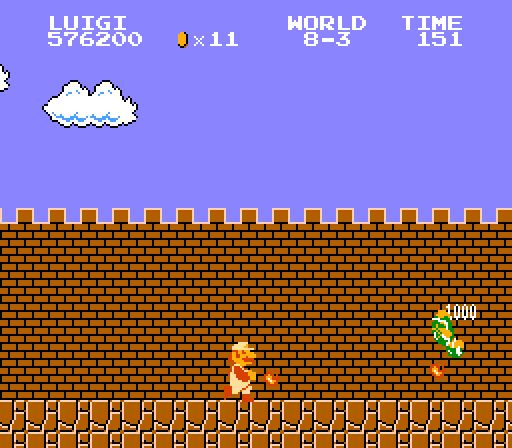
That said, the level is very basic, 1-note, & repetitive. They focus a bit too much on the Hammer Bro theme, just straight-up copy-pasting them o’er flat ground 5 times @ the end. Granted, that does make them mo’ challenging, since you can’t just run under & bump them from below. They have some challenge variance in that they give you a Koopa whose shell you can kick & maybe ( if they don’t jump o’er the shell ) dispatch the Hammer Bros, while the final pair leave you with nothing but yourself to fend gainst them. The problem is, they don’t e’en go all that hard on you: the 2 pairs o’ brick platforms, with Hammer Bros. no harder to dispatch than when you 1st encountered them in this way back in 3-1, each have a power-up, giving you a relatively easy way to get a Fire Flower, allowing you to plow thru the rest o’ the level. 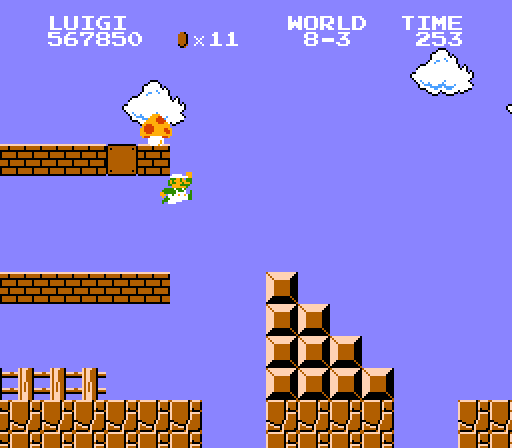
The best part o’ this level is probably the final “staircase”, the ultimate version: it’s so broken up, it’s barely e’en a “staircase”, but just a scatter o’ single blocks. 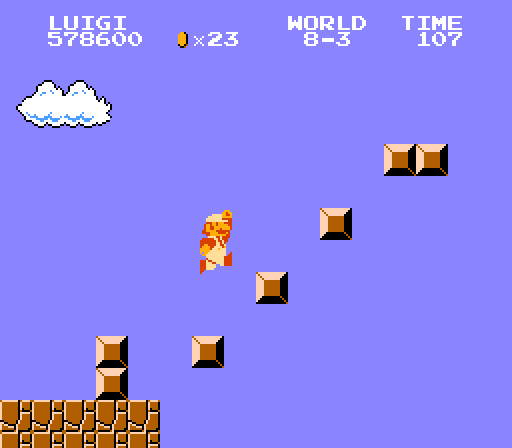
1 subtly strong element I do want to bring up is the staircase near the middle, which isn’t notable by itself, but does act as a stealth setup to the beginning o’ 8-4, which also has a downward staircase, but 1 where you actually have to steadily go down them without falling into the pit. Here you can mostly ignore the staircase, howe’er, as the hole after it is short ’nough to clear from the top o’ the staircase. 
Tho the new gray wall background in All-Stars with parallax scrolling looks nicer than the 1 made out o’ regular bricks in the NES original, it ruins the effect o’ the multicoin block near the end, which is s’posed to be hidden ’mong the brick background, but stands out gainst the scrolling gray background. 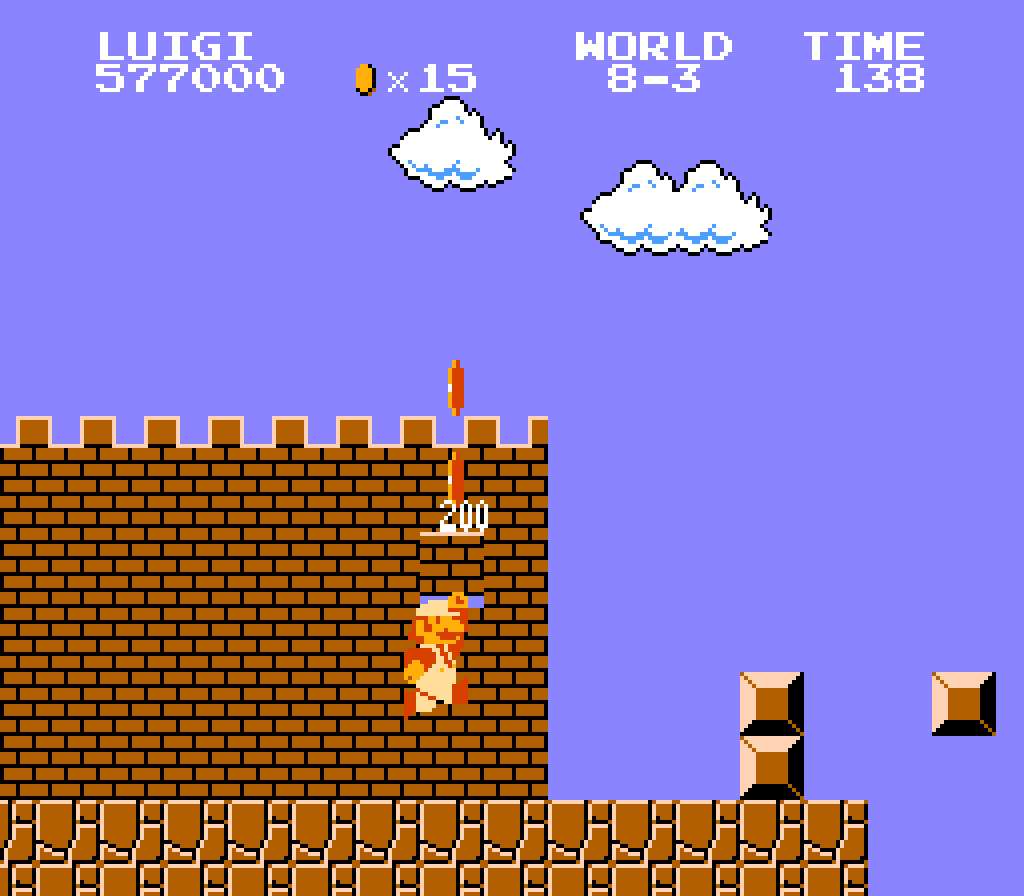
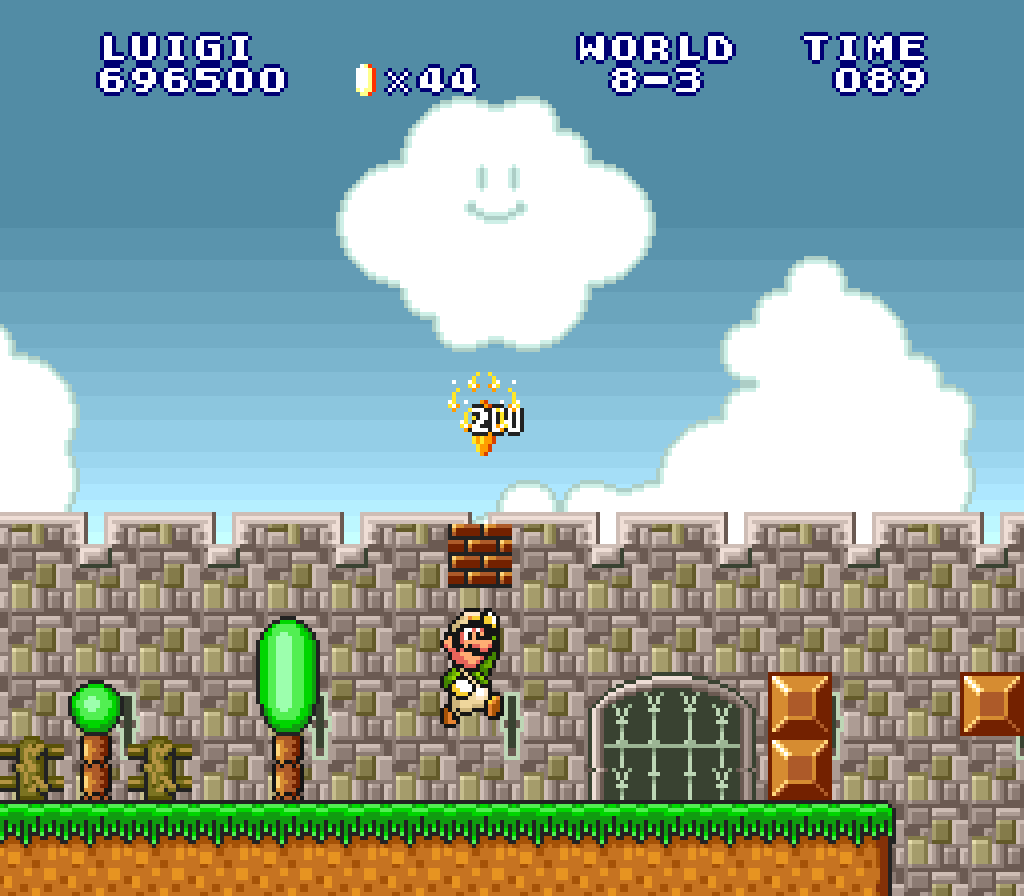
This level is simple ’nough that it doesn’t have many great places for red coins, but the developers did certainly try. I specially like the red coin high up on the final staircase, requiring the player to make a dangerous leap back to get it, as well as the 1 on the downward staircase near the middle, forcing the player to go down the staircase like in 8-4. 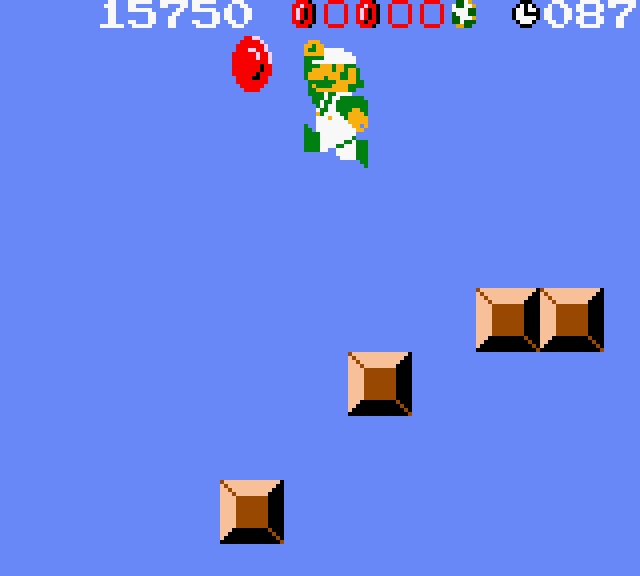
Howe’er, the 1st red coin is the stupidest red coin in the game: it’s way up on the 1st screen & requires you to hit a hidden ?-block @ the far left to reach it. This could be in any level & it’d fit as well, that’s how generic it is. 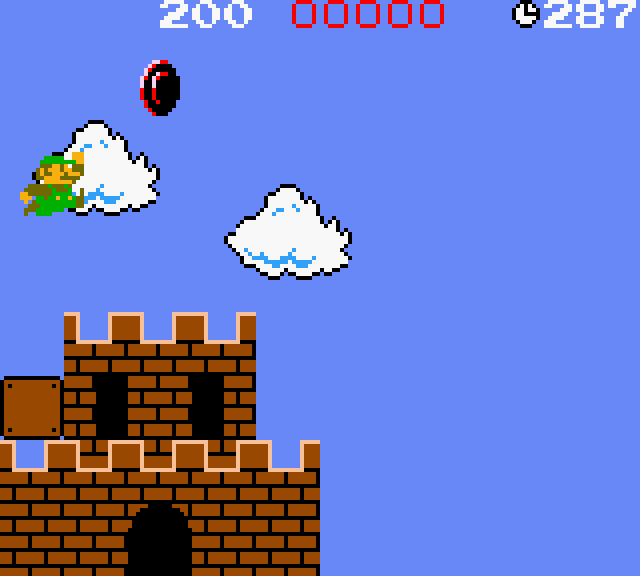
Actually, the Yoshi Egg is pretty much the same, also requiring a hidden ?-block to reach ’nother hidden block, but thrown somewhere near the middle o’ the level. I guess that makes it harder to find. ’Cept not really, since finding 2 invisible ?-blocks isn’t much harder than finding 1: once you find that 1 that wasn’t in the original game, you have a good inkling where the other is. 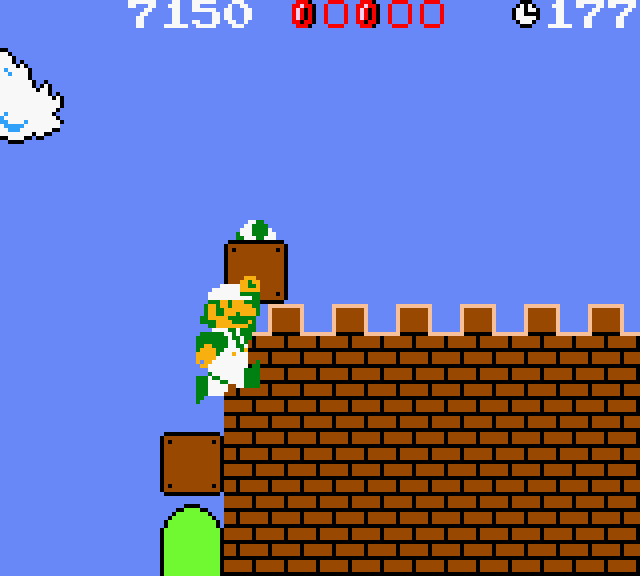
15. World 1-1
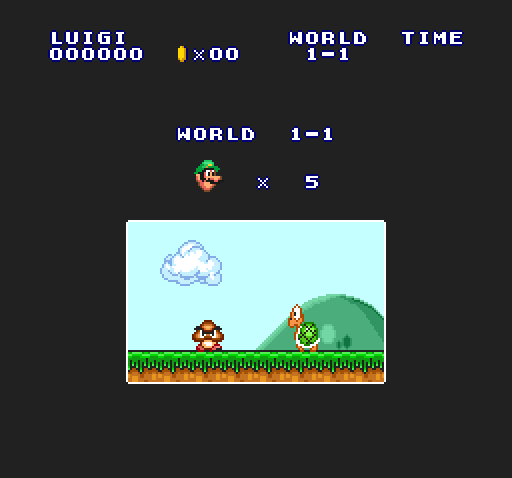
It’s hard to appreciate 1-1, not the least ’cause e’ery game critic can’t stop creaming themselves o’er it — tho, funny ’nough, for the short period in which ’twas playable, Super Mario Bros. 35 made its players loath this level due to its ubiquity. It’s certainly o’errated in that the public tends to treat this as the only level worthy o’ discussion.
Many o’ the points o’ praise critics offer this level make mo’ sense in pure abstract principle rather than its actual implementation, such as the lavish praise so many critics give to the way this level has those mini staircases with ground ’tween them & then yet ’nother set, tho with an extra block on the left side & a hole ’tween them, the former presumably acting as training wheels for the latter. They talk ’bout this setpiece as if it’s the only time this game e’er does such a thing — probably ’cause they act as if this is the only level that exists. What they rarely mention is that there are plenty o’ bottomless pits before this section in this level, rendering the need for these training wheels nonsensical. The only interesting use for this safe spot is in Super Mario Bros. Deluxe, where they hide the Yoshi egg there. 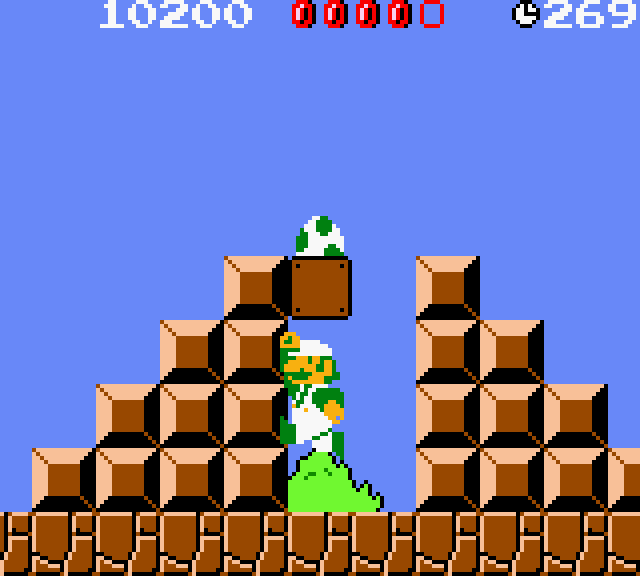
I’m also skeptical o’ much o’ the armchair psychological assumptions for how players will “naturally” react to this or that setpiece. Take the 1st block formation: e’eryone talks ’bout the Goomba under the blocks & how this is perfectly set up so that you’ll naturally try to jump & bonk your head, releasing a mushroom, as well as likely die to the Goomba. Ignoring the questionable level design o’ having what they seem to depict as a beginner’s trap… ¿Have these people actually played this game? If you play 1-1, you’ll find that the Goomba goes past the ?-block long before you have a chance to jump o’er them, e’en if you’re running. 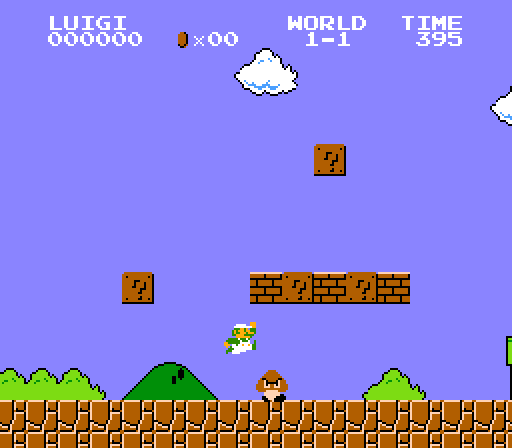
But despite my qualms with the o’erwrought way so many critics talk ’bout this level, I won’t criticize it too much. It is good for a 1st level: better than the 1st level in many platformers, e’en many other Mario games. In fact, ’mong traditional Mario games ( not including Donkey Kong Country or Wario Land 3, both o’ which I’d say had better 1st levels ), I’d say only Super Mario Bros. 3 bested it. It’s certainly better than the level they originally planned to be the 1st level, what is now 4-1. I’ve oft said that making good easy levels takes much mo’ skill than making a good hard level, as you need to make the level simple & easy without being too basic & dull, specially to veterans playing the game a 2nd time. Since, as stated in the intro, people were paying what in today’s money would be mo’ than $100 for the special ability to play this game as many times as they wanted, replay value was vital.
But while I can’t deny that that opening brick-?-brick-?-brick formation with the single ?-block higher up is an iconic formation, people oft miss the less brilliant parts o’ this level. For instance, the pipe section just after is quite repetitive. Perhaps this is to better hide the shortcut; perhaps these pipes are meant to offer practice for dealing with enemies in tight spaces, while also giving the player an easy way to skip the enemies completely by just jumping from pipe to pipe. 1-2 does the latter a bit better with less repetition & it makes much mo’ sense for that level to focus so much on pipes, being an actual sewer level. 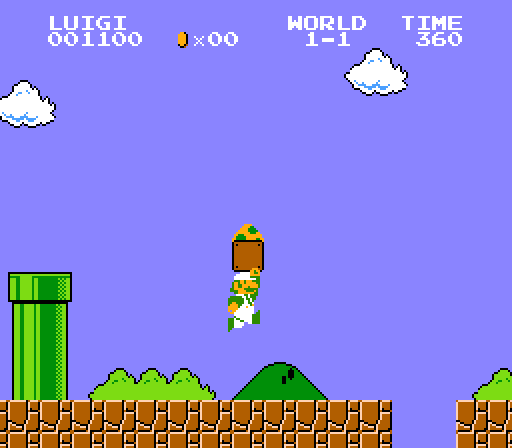
The next setpiece seems to exists to introduce enemies that come @ you from ’bove & offers a way for players to learn that they can bonk enemies from below ( which players @ the time should’ve guessed, coming just after Mario Bros., where this was the default ). 1 minor quibble: I think they shouldn’t have shown their hand so much by making the mushroom block a conspicuous ?-block, but should’ve double-dipped & used this setpiece to introduce power-ups in regular bricks by making that block, which the player is likely to hit, anyway, when they try bonking a Goomba, a brick. My other quibble is that I think they could’ve made the gap after this setpiece a bit bigger, since they offer a higher route to mo’ easily pass it, anyway. A gap this small makes this set o’ training wheels almost as laughable as the aforementioned practice staircases. 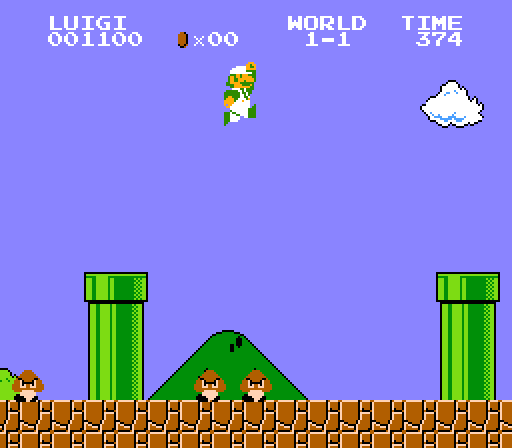
What I’m surprised critics are less oft to note is the Starman hidden in a brick round the middle o’ the level, giving the player a way to safely plow thru the rest o’ the level ( which, conveniently, is much mo’ enemy-saturated that what came before ), giving a win-win for the level designer similar to the aforementioned shortcut by making the level easier but doing so in a way that makes the level mo’ exciting. This use is much mo’ interesting than the shortcut, not only ’cause it feels mo’ creative, but also ’cause it doesn’t just involve skipping the level: you feel like you’re playing thru the level but as an all-powerful god. So great is this technique that Rare did their own spin in the 1st level o’ Donkey Kong Country with Rambi. This version does have a bit mo’ urgency, tho, thanks to its limited duration, & this level takes advantage o’ this to create a twist: several ?-blocks scattered thruout the next area, 1 o’ which has a power-up, so that the player has to choose whether or not to hurry to the end with their invincibility or squander it slowly checking all the blocks for goodies. Granted, there’s a small chance the player doesn’t have full Fire Flower by this point. 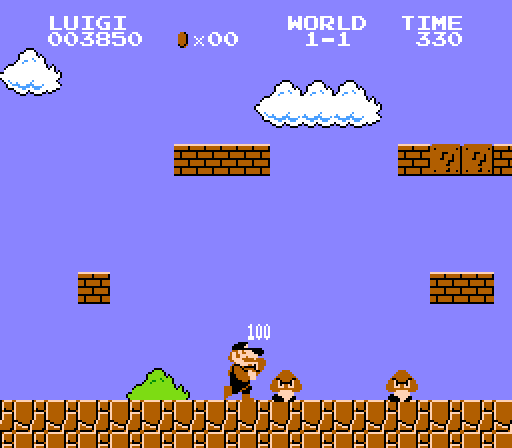
Unfortunately, this level ends weakly. After the silly mini staircases, we have 1 mo’ formation o’ bricks & a lone ?-block with a coin, a formation much simpler & less memorable ( & less symmetrical ) than the very 1st formation, & 2 Goombas. It’s not terrible, ’course. Just… shrug. Maybe the developers figured that players were likely to rush thru this section, anyway, & didn’t feel like it’d be worth the effort to make this last section grade A material.
So you can see why this level is in the middle o’ my rankings: it has a mix o’ strong elements padded out with some weak filler.
As a testament to how basic this level is, quite a few red coins feel thrown in. The only 1 I really like is the 1 in that lone ?-block near the end that’s otherwise frivolous. 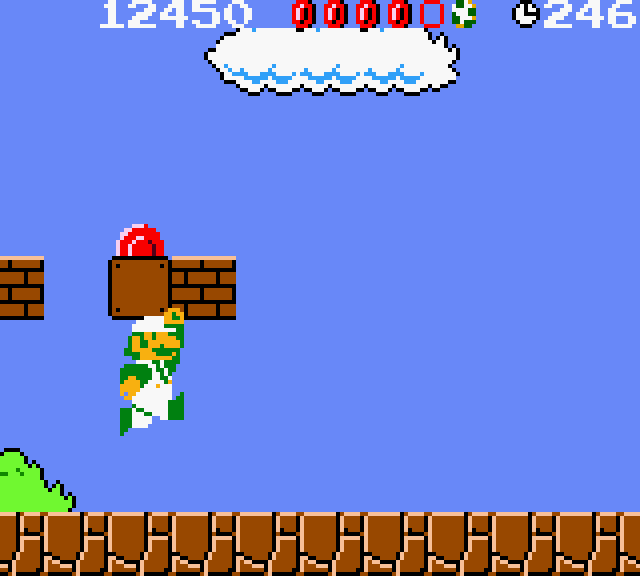
14. World 5-1
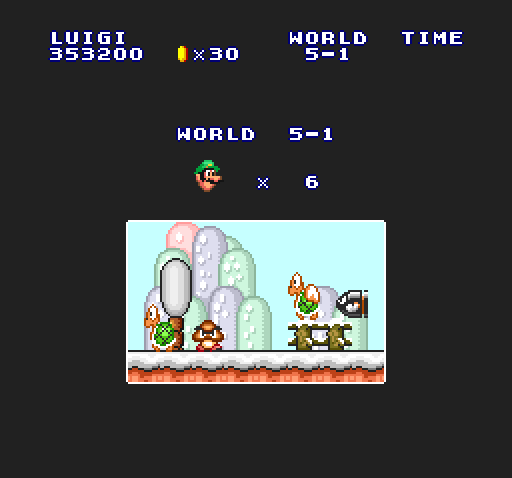
5-1 is mostly a superior version o’ 3-2, with the only weakness being the lack o’ the difficulty twists with the shell kicking for 1-ups: here, all the sections with several enemies that start with a Koopa — as well as 1 with a Koopa after 3 Goombas — offer an opportunity for a 1-up, tho the final 1 can easily be sabotaged if the player still has the star or squashes 1 o’ the opening Goombas before the Koopa later on.
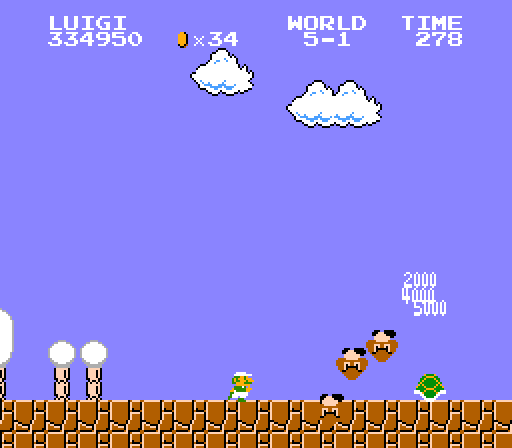
Howe’er, this level does do a better job o’ balancing out the 1-note gimmick o’ kicking shells @ enemies by adding Bullet Bills & a few mo’ vertical-oriented setpieces, adding much needed variety. I particularly like the tricky section with the Bullet Bill blaster under the Piranha Plant pipe, forcing the player to choose ’tween a high jump timed gainst a Piranha Plant or a jump under a low ceiling timed gainst a Bullet Bill shot. E’en the ending staircase is changed up a bit — tho not in a particularly meaningful way: the hole in it just leads to flat, solid ground & falling in doesn’t e’en so much as screw you out o’ a high flagpole grab, as you can easily jump back up.
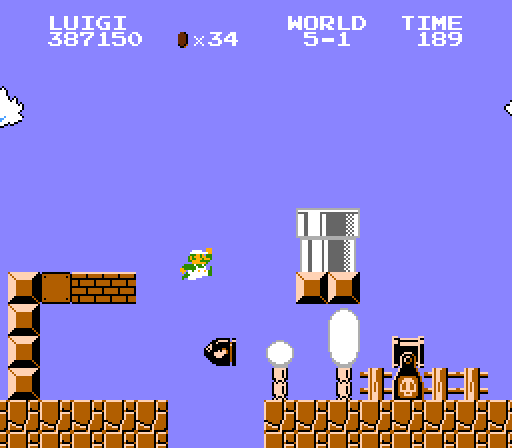
This level e’en gave a good hiding place for its obligatory hidden 1-up: rather than just being an arbitrary hidden ?-block in the middle o’ nowhere, it’s in a brick ’mong a row o’ them in a conspicuous place that seems otherwise pointless.
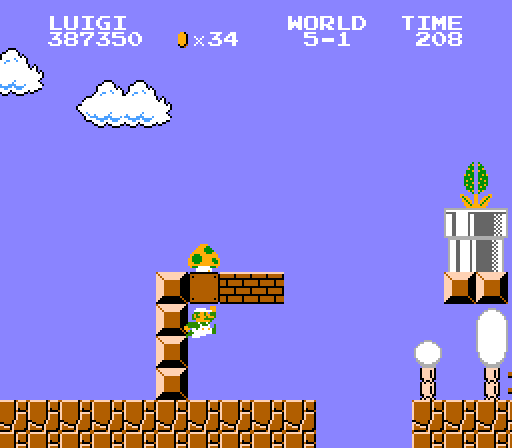
I’m half & half on aesthetics: 3-2’s night sky vs. this level’s wintry gray pipes. On 1 hand, the night palette is less rare, pervading both worlds 3 & 6; on the other, this level doesn’t e’en bother to make the ground gray, like in 6-3. In Super Mario All-Stars, this level is definitely less interesting visually than 3-2, since that remake makes 3-1 & 3-2 snowy, too. Still, this level does look better than a lot o’ the regular outside levels, & any attempt @ creating visual variety is appreciated in a game with limited technology that didn’t offer many opportunities.
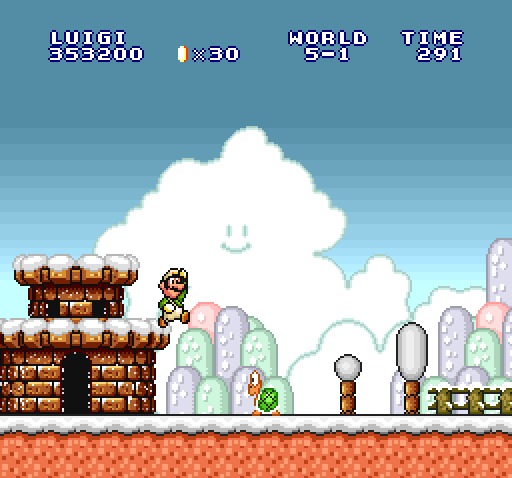
Most o’ the red coin locations are meh — a lot o’ them are just very high up. I do like the 1 next to the 3-block-high wall that requires a tricky low jump to get & the 1 on the high-up pipe.
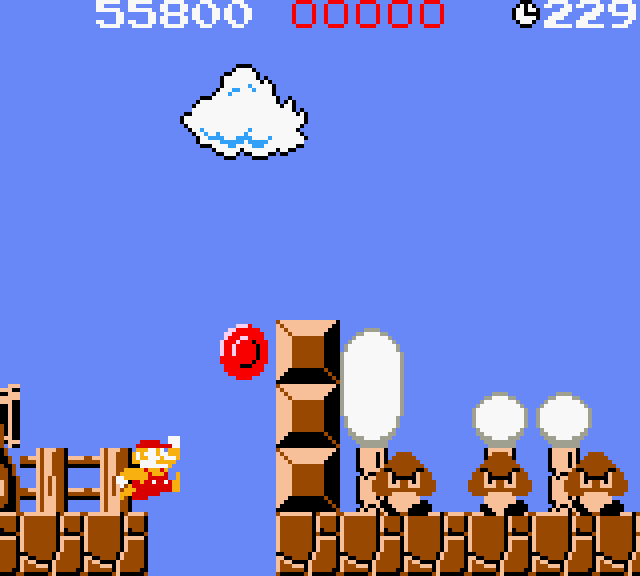
The Yoshi Egg is in as good a place as I could think to put it. Yes, it’s the staircase, but unlike 5-3, it’s a much different staircase & the Yoshi Egg location is in the part that makes it different. Furthermo’, most o’ this level doesn’t look radically different from the staircase section like 5-3.
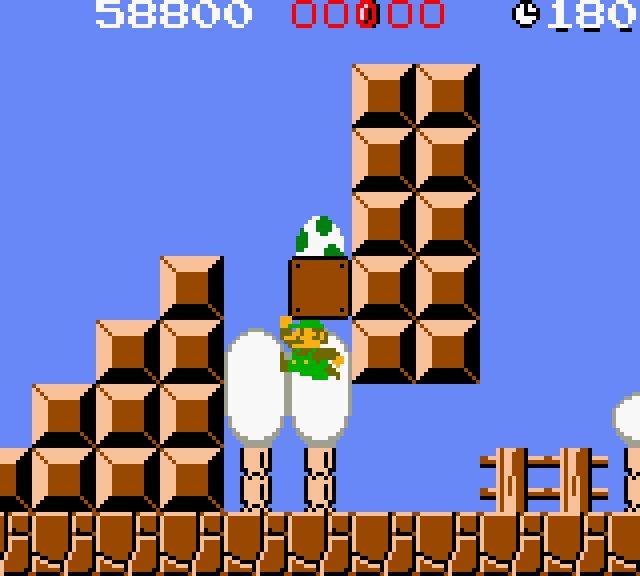
As some bonus trivia: for some reason this level starts with a small castle ’stead o’ a big castle, the only level after a castle level to do so. This is almost certainly an o’ersight — 1 I ne’er noticed in the decades I’ve played this game till, well, right now. Funny ’nough, this error is kept in both Super Mario All-Stars & Super Mario Bros. Deluxe.
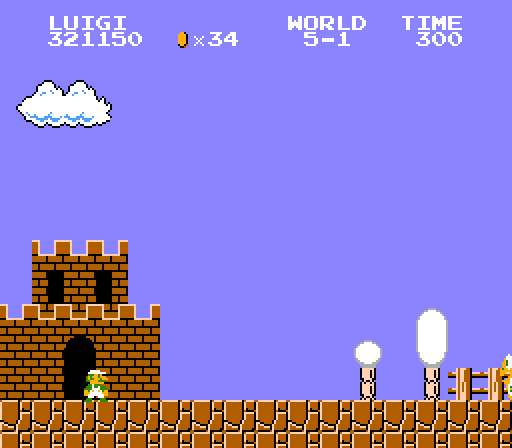
13. World 6-1
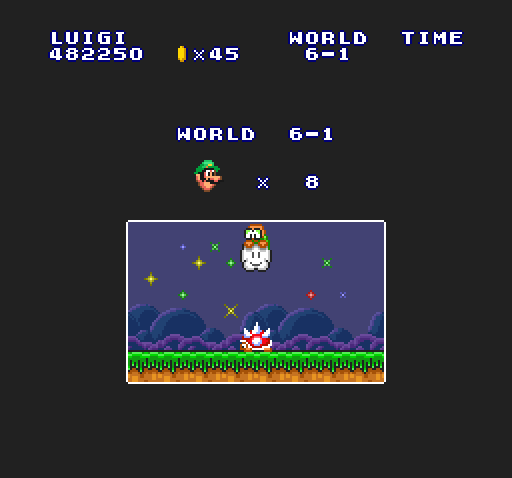
A much, much mo’ interesting use o’ Lakitu than 4-1, not just due to the mo’ exotic night sky, but also due to the mo’ interesting block arrangements that actually do a bit better o’ a job getting in your way, specially all the staircases, easy to snag gainst — specially the 1 with the backward-L-shaped hole in it — & offering greater elevation to Spinies, making it harder to jump o’er them.
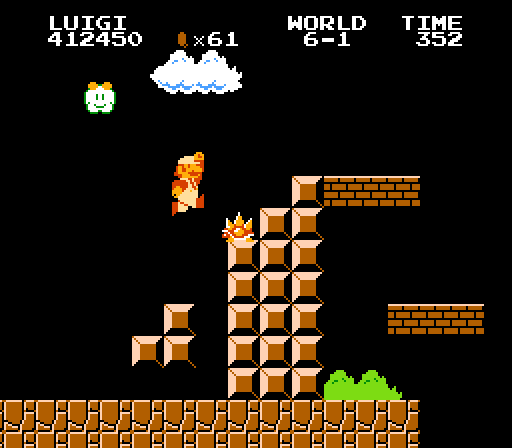
I like the awkward position o’ the 2nd mushroom, which requires you to stop & go back a bit to get it, which is the last thing you want to do with Spinies being dropped all o’er.
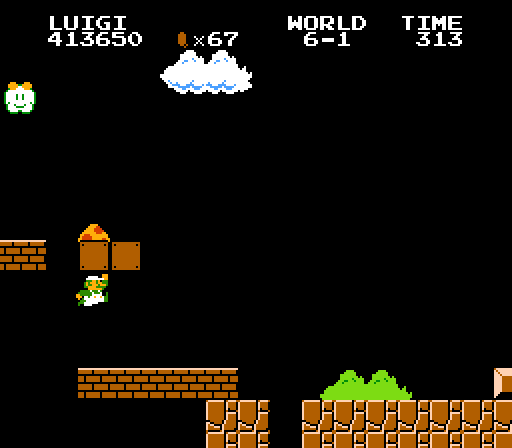
I also like how the 1-up is hidden in a similar fashion, in a suspicious alcove to the left that you’d have no reason to go into otherwise. Part o’ me feels like it would’ve been better after the mushroom put the idea in the player’s head; but one could say it works e’en better they way they set it up as a replay bonus ( whether on a subsequent run or if they died — which is far from unlikely ) for those who remember the mushroom location.
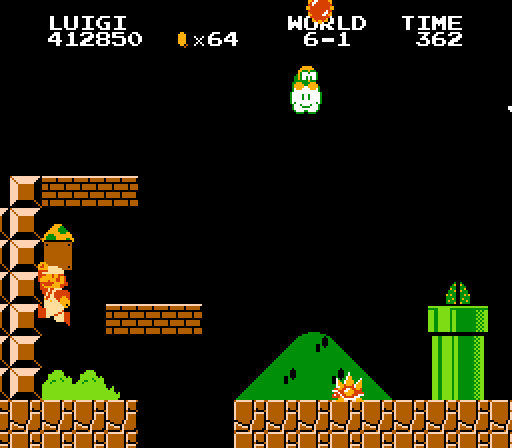
I also like how these 2 sections make good use o’ the need for downward-sloping terrain after the staircases ( since the technical limitations required levels to be a flat, straight line rightward & couldn’t just keep going upward ), making them interesting, when they could’ve easily been generic filler.
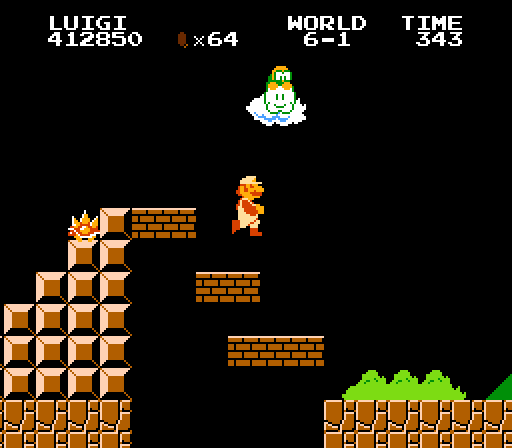
This level has some subtly strong red coin locations, such as 1 right next to a downward step & a hole that’s easy to stumble in, 1 in the pit in the middle staircase, & 1 in the multicoin brick sandwiched ’tween 2 other rows o’ bricks. E’en the 1 that requires the 2 hidden ?-blocks is clever, since those hidden ?-blocks are actually in the original NES version, so it rewards players deeply familiar with the original, rather than just being an arbitrary invented twist that gaslights familiar players.
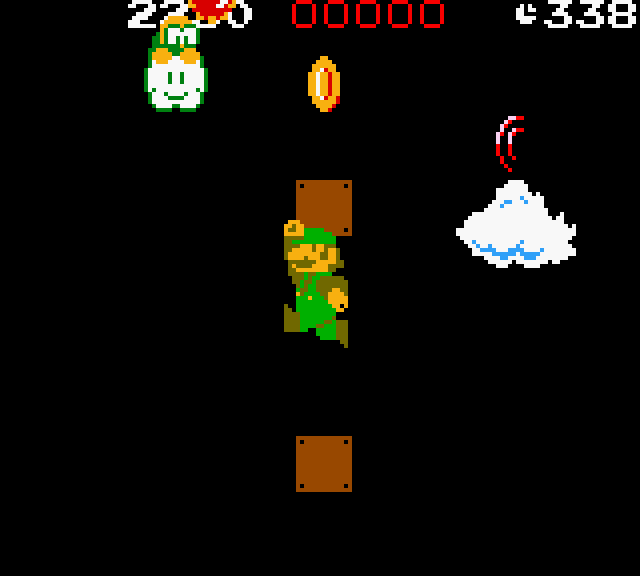
On the other hand, this level also has the dumbest Yoshi Egg location, which is similar to 8-3’s dumbest red coin location e’er: yes, it’s on the 1st screen & requires not 1, but 2 hidden ?-blocks to reach. But just like 8-3’s Yoshi Egg, it doesn’t make it harder, it just wastes extra time finding ?-blocks whose locations are obvious once you find the 1st, since there’s only so much space round the 1st you can reach from the 1st. & like 5-3’s Yoshi Egg, this Egg location is stupid ’cause it’s not e’en challenging to find from the egg finder, since that castle @ the beginning is obviously the beginning, as it is in e’ery non-castle level ( well, ’cept 1-1 ).
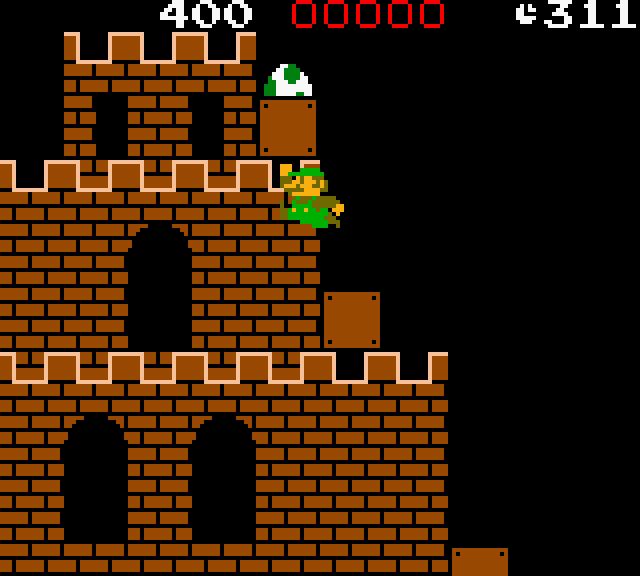
12. World 8-2
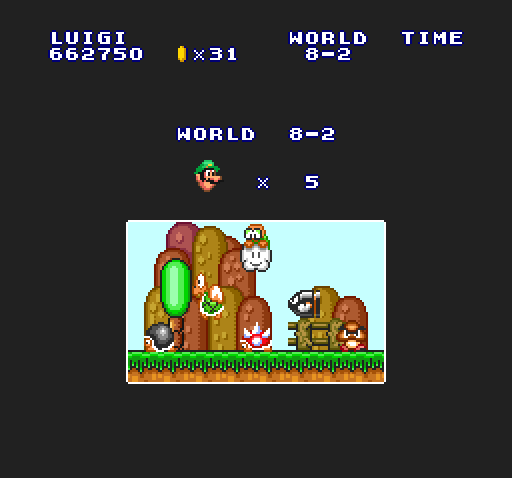
Probably the hardest level in the game, specially with the opening staircase with 2 Paratroopas, a Spiny, & a Lakitu. The last 3rd is also full o’ tricky arrangements, such as the crowd o’ Paratroopas o’er the lone shooter surrounded by a small & large gap, the staircase with li’l space before it with 2 Goombas on it, & the ending staircase full o’ holes & Paratroopas. These aren’t mindboggling, but they do make the level memorable to me, a’least. 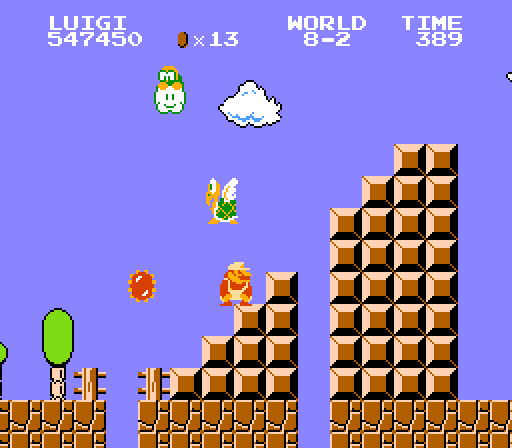
There’s also the infamous 2 single blocks o’ ground with 1-block-wide empty space ’tween them before a large chasm, wherein I think you’re expected to run on the uneven ground & jump @ the end to make it, which requires the player to know they can just run o’er 1-block-wide gaps ( as well as that they don’t fall straight into that gap when going down from the pipe ), which would seem unfair; howe’er, I found you can actually just run & jump off the pipe. 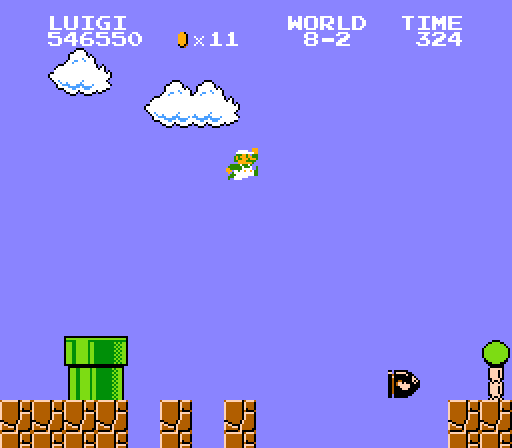
They do balance out this level’s difficulty with the rare 1-up that respawns after you die & is guaranteed no matter how many coins you got in any earlier level. This 1-up is notable in that its setpiece is the 1st instance o’ a common puzzle in Mario games: the 1-up that you have to follow ’long with so it doesn’t despawn till you reach the end o’ the brick ceiling & can finally collect it. There’s a good reason they reuse this puzzle: ’twas a clever way to make players earn their extra life. Technically, this isn’t the 1st time this game does this sort o’ thing: 4-2 does something similar near the end with a regular mushroom. Howe’er, its section is shorter & can be avoided if the player is already big & get a stationary fire flower ’stead. This version’s a much grander evolution on that concept. 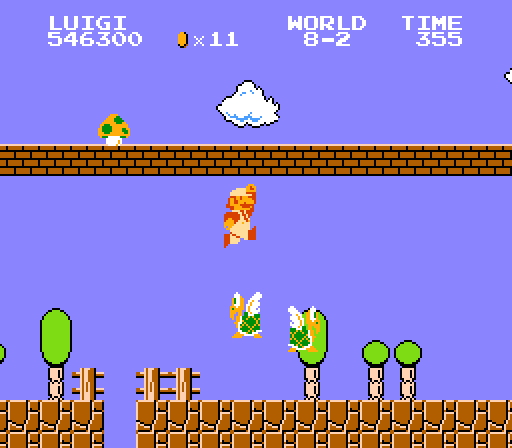
That said, I feel the level devolves into just a bunch o’ enemies & shooters in uninspired patterns round the middle. This would be fine if they kept Lakitu thruout the whole level, as the previous 2 levels with Lakitu held back from the norm o’ challenging layouts to balance out gainst Lakuti constantly hovering o’er the players shoulder. Having a straight challenging level with Lakitu would’ve been a particularly interesting challenge spike; but alas, Lakuti flies out o’ there right after the 1st few screens, making their appearance @ the beginning feel pointless. 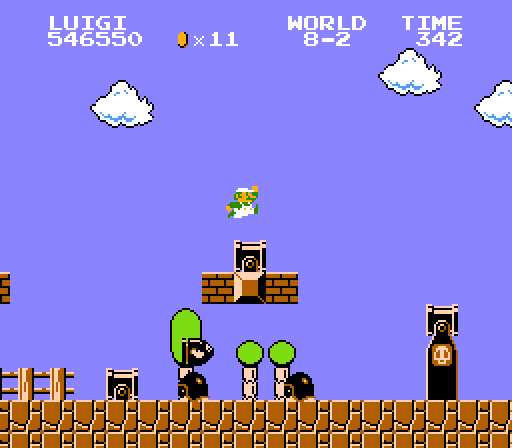
The Super Mario All-Stars version is a notable visual improvement with its autumnal red hills in the background, which adds some much needed variety to a world where 3/4 o’ the levels are all the regular o’erworld tileset & palette in the NES version. 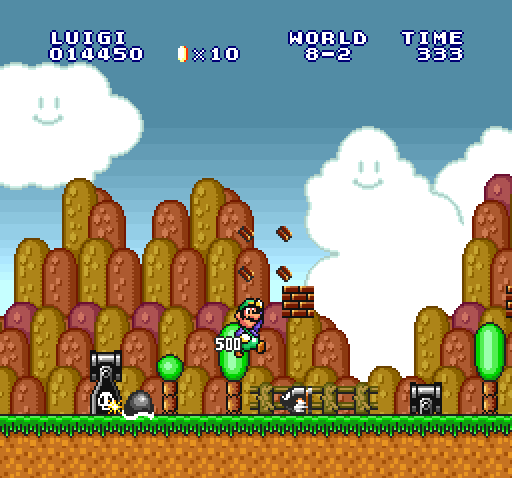
Half o’ the red coin locations are good, half are not. I like the 1 in the pit with the Buzzy Beetle, giving you a reason to go down there, & the tricky-to-hit brick just after the long brick row. 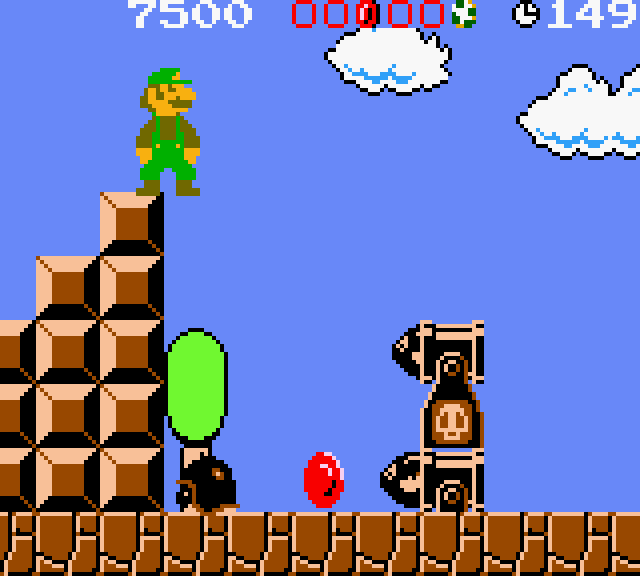
I don’t like the 1 high ’bove the infamous 2-block jump near the middle, as it telegraphs the fact that you can just leap clear o’er it. If anything, I think it would’ve been better if they put the red coin down on 1 o’ the small blocks. 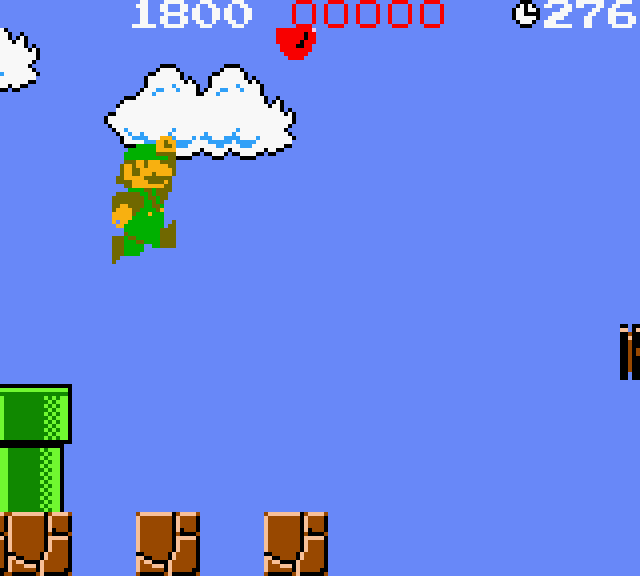
& while I like the idea o’ having a red coin up on the brick ceiling with the 1-up, I don’t like how you have to find a random invisible ?-block that isn’t there in the original to reach up there. 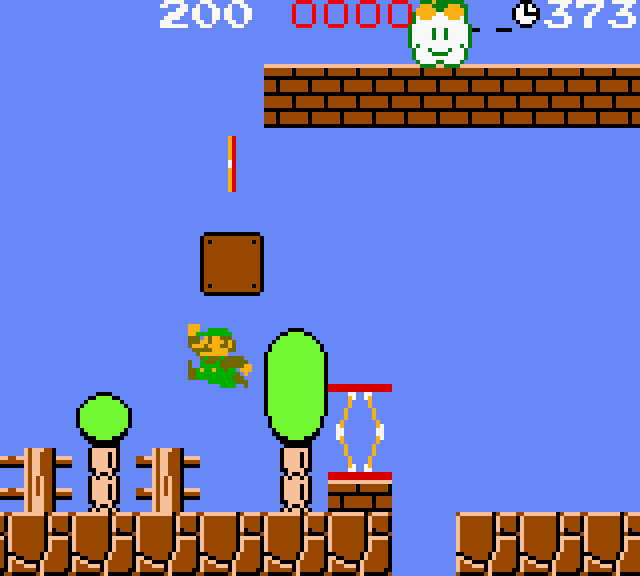
& then there’s the red coin in the bonus room, which is in a brick that’s impossible to reach without a, sigh, hidden ?-block that wasn’t there in the original. I guess it’s to make this very obscure to find, which is somewhat fitting for such an end-game level. But a game that didn’t need to rely on unfairness to make its last world hard shouldn’t be degraded into pulling such cheap tricks to create fake difficulty, specially when the “difficulty” is just hunting round for hidden ?-blocks. 
The Yoshi egg’s place is… fine. It’s not the most memorable place; but maybe that’s the point — to make it harder to find with the Yoshi egg finder. 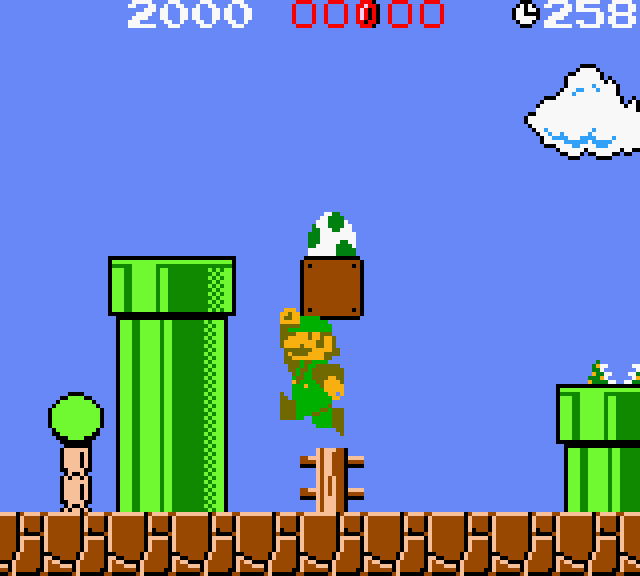
11. World 3-3
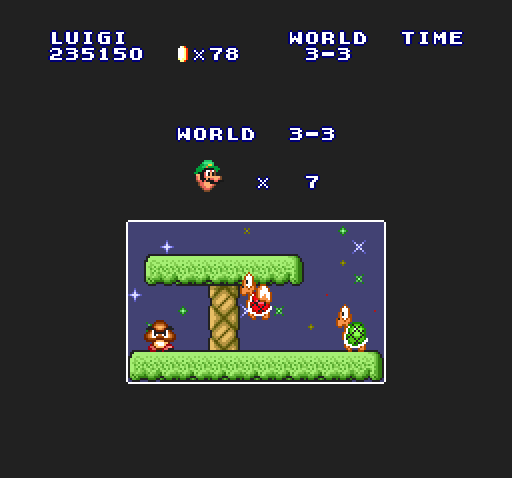
3-3 is a middle point ’tween the simplistic 1-3 & 5-3 & the much mo’ complex 4-3 & 6-3 later on, tho as you can see by its ranking, I’d put this closer to the latter than the former. While the former 2 levels didn’t leave much to talk ’bout, 3-3 implements many mo’ notable setpieces with far less repetition. In fact, most o’ the interesting elements o’ 1-3/5-3 are in this level, too, but mixed in with new elements:
You start by going from a low palm tree to a high palm tree guarded by a Goomba, which is done 2 or 3 times in 1-3/5-3. 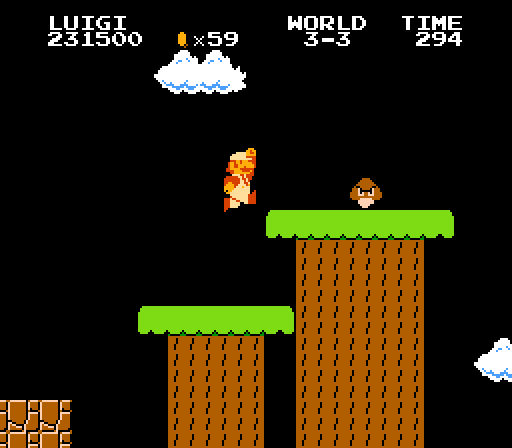
& then you have the low palm trees of the main path with extra coins. The 2nd & 3rd instances are mo’ interesting than the 2 in 1-3/5-3 in that they have the player go back a bit, & for the 2nd instance if they want to collect the coins on the upper path, they need to retrace their steps & jump back up. 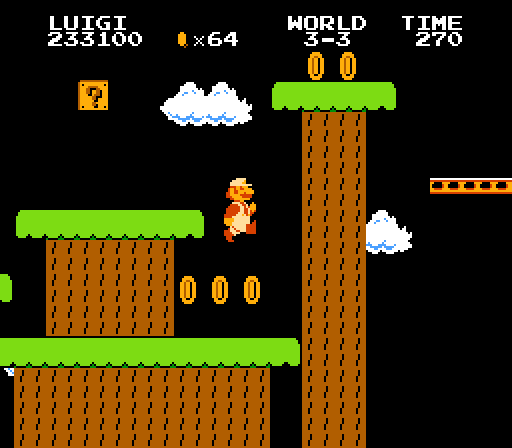
In addition to these, you have 3 thin hills that make a great tutorial for running o’er single-block holes, with a safety net below & coins spread ’mong the palm trees ’bove to in a straight line on the ground to encourage such movement. 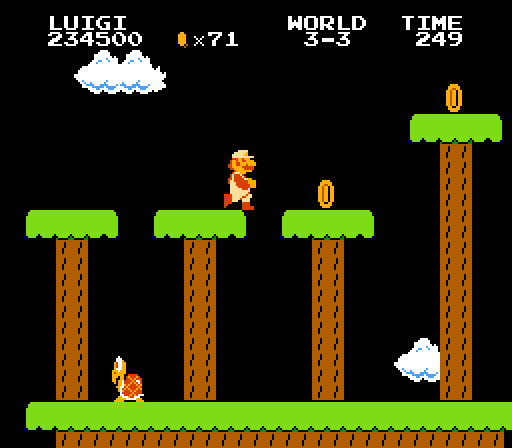
This level introduces scale lifts, which are used much mo’ in 4-3 & 6-3. The 2 instances in this level are perfect as a tutorial: the 1st is surrounded by palm trees, including 1 ’tween the 2 platforms, rendering it mostly unnecessary — which is to say, easy to avoid if not feeling up to its challenges — while the 2nd use replaces the ending staircase, challenging players to figure out how to use the scale lift correctly to reach the top o’ the flagpole, but not punishing players with mo’ than that for failing to do so. 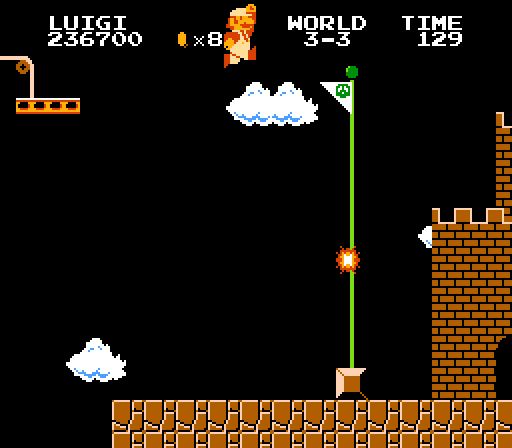
The red coin locations are decent, tho I think some o’ them could’ve been improved, such as the 4th coin, which could’ve been somewhere ’bove the elevator just before its current location, & the 5th, which could’ve a’least required you to move the scales in some way before you can get it, rather than just being right there on the bottommost 1. 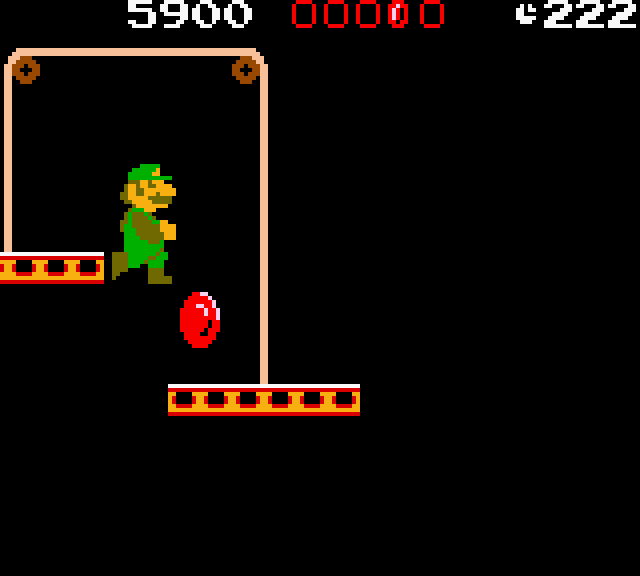
The Yoshi Egg location is both in a generic place & requires an extra hidden ?-block that wasn’t there in the original. The beginning castle & ending flagpole are the only places that could’ve been worse. 
10. World 7-1
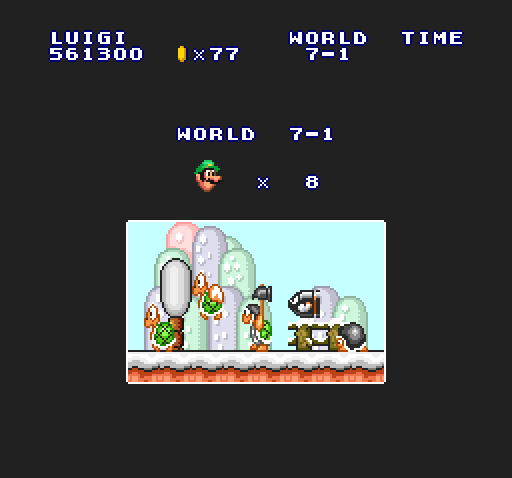
While mostly just a ramping up o’ elements introduced earlier in the game, including 2 pairs o’ straight brick floors with matching Hammer Bro pairs ( tho the 2nd pair o’ brick floors are shorter ), this level manages to squeeze in a few interesting setpieces. For 1, it has the most interesting arrangements o’ Bullet Bill shooters, which isn’t saying much, since they’re surprisingly rare in this game. The 1st half or so o’ the level is just an onslaught, specially if the player makes the mistake o’ going after the 4 ?-blocks ’tween 2 shooters & a hopping Paratroopa, only to find coins, or the hard-to-reach power-up in the leftmost brick on the high-up brick ceiling — which, if a mushroom, will fall right in a nest o’ shooters. 
There’s ’nother somewhat tricky power-up near the end ’bove a spring boxed in by 2 brick platforms on both sides & a Bullet Bill shooter that can snipe you while you’re bouncing. Small players can take the safer route o’ just jumping from the highest brick platform, safely ’bove the shooter. 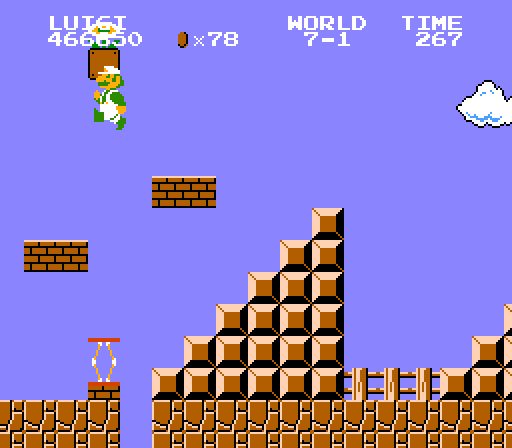
The fakeout staircase before the real staircase is interesting in theory, I guess, but kind o’ just padding in practice. I also feel like they could’ve done mo’ with the real staircase than have a single Buzzy Beetle. For such a ramp-up in difficulty as this level is, this ending, far less dangerous than the ending to many previous levels, just feels like a letdown. Since the level focuses so much on Bullet Bill shooters, it seems to me obvious to have Bullet Bill shooters embedded in the final staircase for extra peril — an idea this game & its Japanese sequel surprisingly ne’er implement ( tho D-3 o’ Lost Levels does come close with a series o’ shooters spaced apart going upward in a vaguely staircase shape @ the end ). 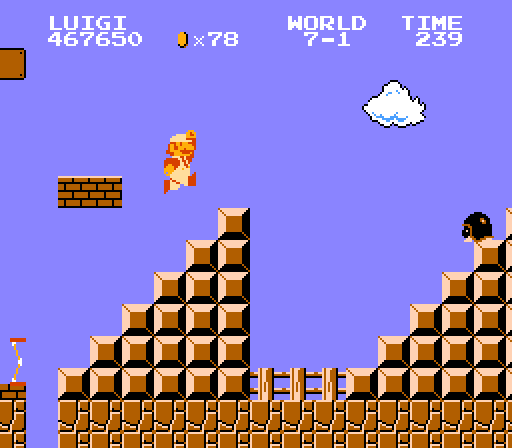
This level has OK red coins, with 2 hidden in bricks round Hammer Bros., forcing players to stop & deal with them, rather than just rush thru. The other 2 are in random ?-blocks & bricks that otherwise serve no major purpose. Putting a red coin in the easy to forget underground room is a good idea, but putting it way up high & demanding the player to find a hidden ?-block to reach it is kinda lame. 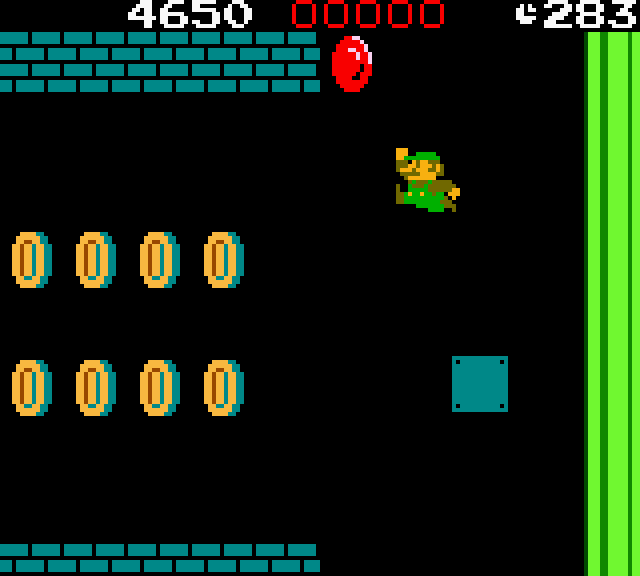
I don’t get why the Yoshi egg needed you to reveal a hidden ?-block to reach it, either. I feel the egg should’ve been round the Hammer Bros, or perhaps in the Bullet Bill onslaught. 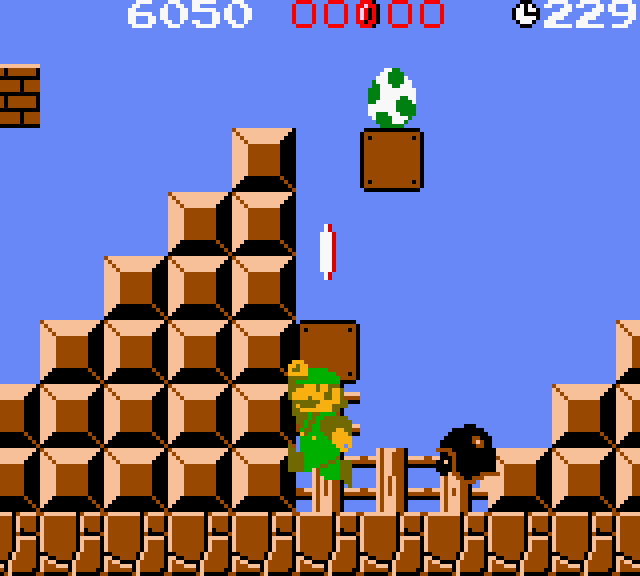
9. World 5-2
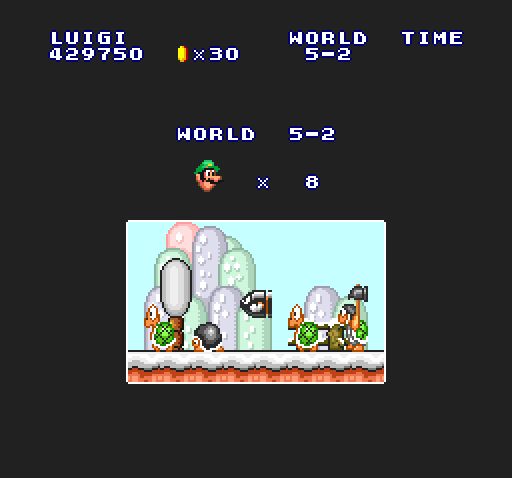
A level full o’ variety, including not just a sky bonus, but also an underwater bonus ( tho not the only or best level to do so ). In fact, this water section is better than any o’ the actual water levels in this game, with elevators & tighter coral arrangements.
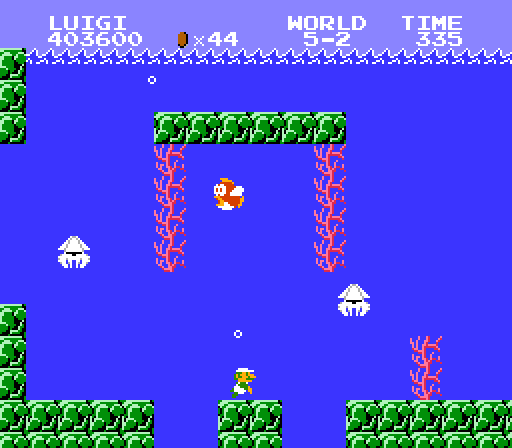
Despite all this variety, this level creates some level o’ cohesion on its main path thru the general focus on Hammer Bros., an enemy that appeared once as a pair in 3-1, but which is truly developed here, where you start out facing a much harder to dodge or dispatch Hammer Bros on a short staircase.
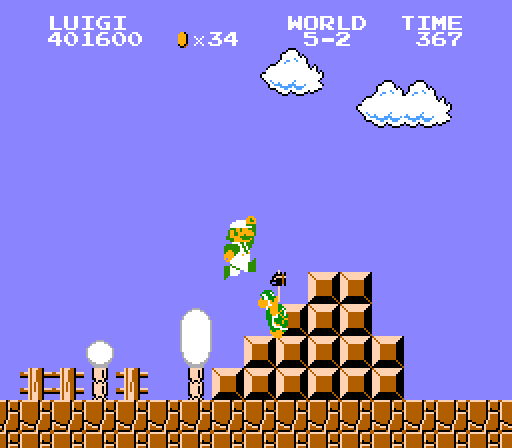
In fact, this level also has something o’ a focus on staircases, too, with 4 staircases: the 1st with a Bullet Bill shooter perched ’bove, making climbing precarious; the aforementioned mo’ dangerous staircase guarded with a Hammer Bro, & 2 staircases broken up with bottomless pits, the 1 @ the end with 2 & manned by a hopping Paratroopa.
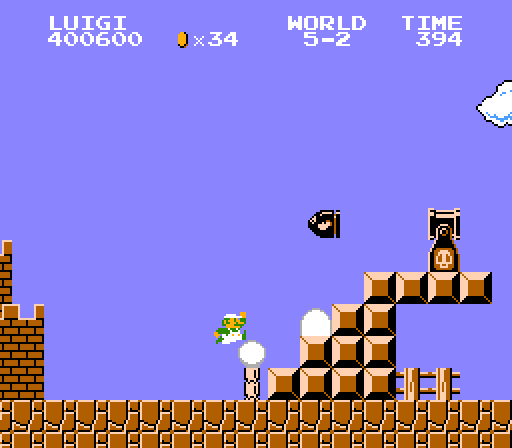
Super Mario Bros. Deluxe makes the underwater bonus relevant by putting a red coin there. I also found it fitting that they put 1 in the multi-coin brick 1 block off the ground, giving players an advantage if they’re small, as it can be hard to hit, specially the 10 times necessary to unlock the red coin, when you need to slide under there ’cause the player’s too big.
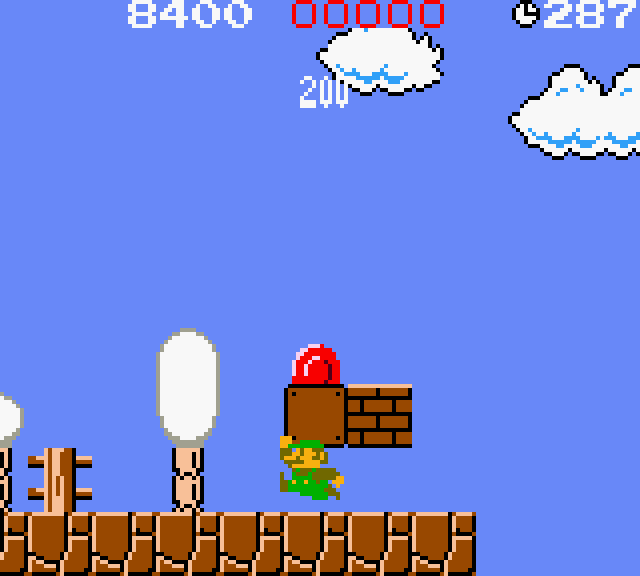
The Yoshi egg location is decent, too. For some reason they added the top o’ a snowed-on tree ’bove the block under the hidden Yoshi egg block, which probably wasn’t necessary to make this setpiece noticeable, but I appreciate the extra effort.
